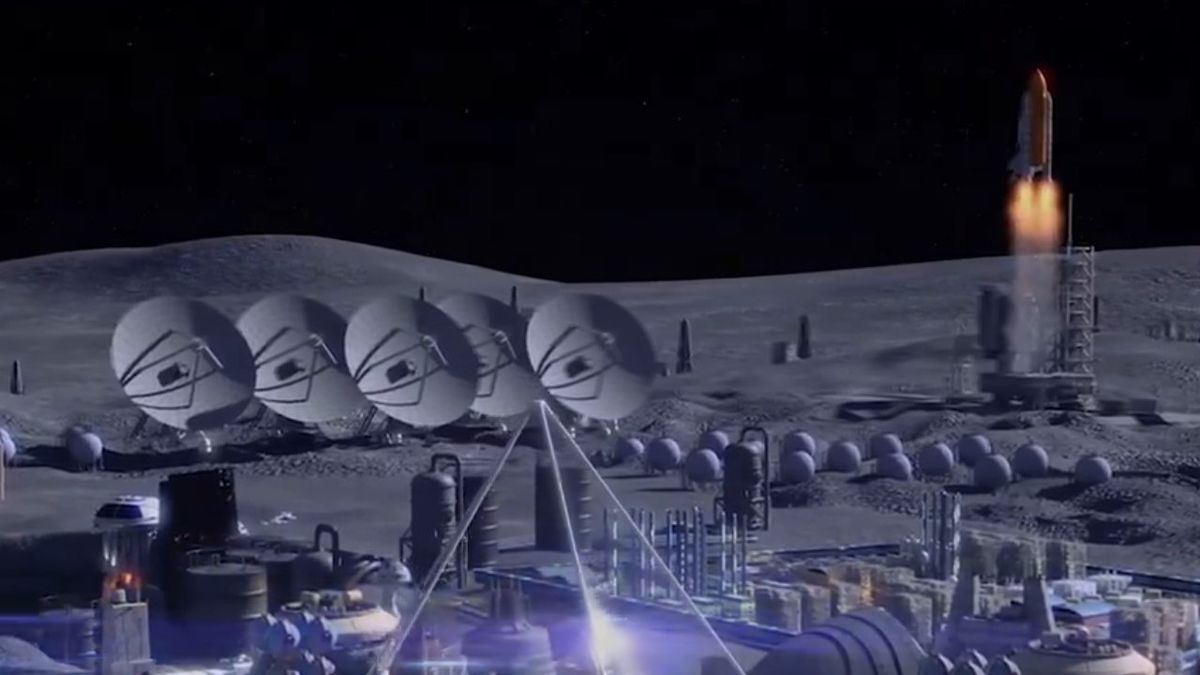Moon RACER: Intuitive Machines launches lunar rover for its first drive.

Moon RACER: Intuitive Machines takes lunar rover out for debut drive (Image Credit: Space.com)
HOUSTON — Intuitive Machines’ lunar terrain vehicle (LTV) is not your grandfather’s moon buggy (assuming your grandfather was an Apollo astronaut).
The company’s Moon RACER, or Reusable Autonomous Crewed Exploration Rover, made its public debut on Thursday (Nov. 7), taking a spin in the parking lot at Space Center Houston. The fully electric drivable demo unit, which was built for Intuitive Machines (IM) by the high-performance automotive company Roush, will be on display on Friday (Nov. 8) for the public and students taking part in National STEM Day activities at the visitor center for NASA’s Johnson Space Center.
“We are extremely excited to show it to you today,” said Trent Martin, senior vice president for space systems at Intuitive Machines, addressing the NASA officials, industry partners and press that came out for the reveal. “In a week, we’re taking it out to Meteor Crater in Arizona, and we’re going to test it in the environment similar to what we would have on the moon.”

As the Houston-based company that returned the United States to the moon’s surface with its Odysseus Nova-C lander in February, IM was one of three firms selected to develop an LTV for NASA’s Artemis program. The $30 million contract tasks IM and its team of subcontractors with creating a feasibility roadmap to develop and deploy a LTV on the moon using IM’s heavy cargo class lunar lander.
Working with Roush for the chassis and suspension system, Michelin for tires, Boeing as the design lead and Northrop Grumman for mission planning support (as well as five other aerospace companies), the IM-led team designed Moon RACER to be a cross between the Apollo Lunar Roving Vehicle and a souped-up golf cart, complete with communication antennas, an optional equipment trailer and a pair of longhorns as a hood ornament — the latter a strictly “remove before flight” feature.
“No, we’re not going to fly 7-foot-long horns to the moon, but we thought that it would be kind of fun today, because this is the Texas rover,” said Jack Fischer, a former NASA astronaut who is now Intuitive Machines’ senior vice president for production and operations.

The 14-foot-long by 8.5-foot-tall by 12-foot-wide (4.3 by 2.6 by 3.7 meters) Moon RACER can tow a 108-foot-long (33 m) trailer. Alone, the LTV can reach speeds up to 9.3 mph (15 kph), about the same as its Apollo-era predecessor. It can also traverse slopes up to about 20 degrees and clear obstacles up to a foot (30 centimeters) high — or about the size of a bowling ball.
Moon RACER is equipped with a hazard avoidance system for use when the crew is driving and an autonomous operation mode for robotic exploration.
“The astronauts drive it, but when they’re not there, we will continue to operate that vehicle from here in Houston, from Australia, from the platforms that are on the moon such as the habitat module and from the Gateway that is going around the moon,” said Martin. “It’s also an autonomous vehicle, so we can give it waypoints and say, ‘I want to get over to that blue tower over there,’ and it will make its way to the blue tower, hopefully without falling in a crater along the way.”
In addition to serving as a communications hub between the astronauts, the LTV’s antennas are capable of relaying data via satellite or direct-to-Earth transmissions.

NASA chose IM, as well as Lunar Outpost and Venturi Astrolab, for this first phase of the LTV development program with the intention of selecting one of the three teams to deliver their rover to the lunar south pole and validate its performance and safety ahead of the Artemis 5 mission no earlier than the first quarter of 2030.
“We are in the process of developing our Nova-D lander. We have our Nova-C that we landed on the moon this past February. So the Nova-D is basically seven of those put together, and then this [rover] would ride on top of it,” Ken Salazar, Intuitive Machines’ facilities operations manager, told collectSPACE, noting that Moon RACER does not need to fold up like the Apollo lunar rover for launch. “It is designed to fit inside the fairing of a SpaceX Falcon 9 Heavy [rocket].”
NASA plans to issue additional task orders to provide rover capabilities as needed through 2039.
The LTV services contract has a maximum potential value of $4.6 billion for all awards. The U.S. companies’ rovers will complement the Lunar Cruiser, a larger, pressurized rover being developed by JAXA (Japan Aerospace Exploration Agency) and Toyota for delivery to the moon by 2031.

In addition to IM’s mobile demo unit unveiled at Space Center Houston on Friday, a static mockup of Moon RACER has been delivered to NASA, which is undergoing “human-in-the-loop” testing at Johnson. That unit bears one other “feature” not present on the drivable demo version — the signatures of Apollo moonwalkers Charlie Duke and Harrison Schmitt, who are two out of only six people to ride a rover on the lunar surface to date.
The Apollo 16 and Apollo 17 lunar module pilots evaluated the LTV’s design, with Duke telling IM that the Moon RACER was great and “way more than we had,” while Schmitt took note of handles used to board the rover. “The stair handles are cute, but on the moon, we’d just jump onto the hood,” an IM spokesperson paraphrased Schmitt as saying, in reference to the lower lunar gravity environment.
Follow collectSPACE.com on Facebook and on X at @collectSPACE. Copyright 2024 collectSPACE.com. All rights reserved.





